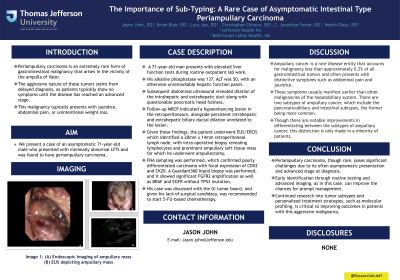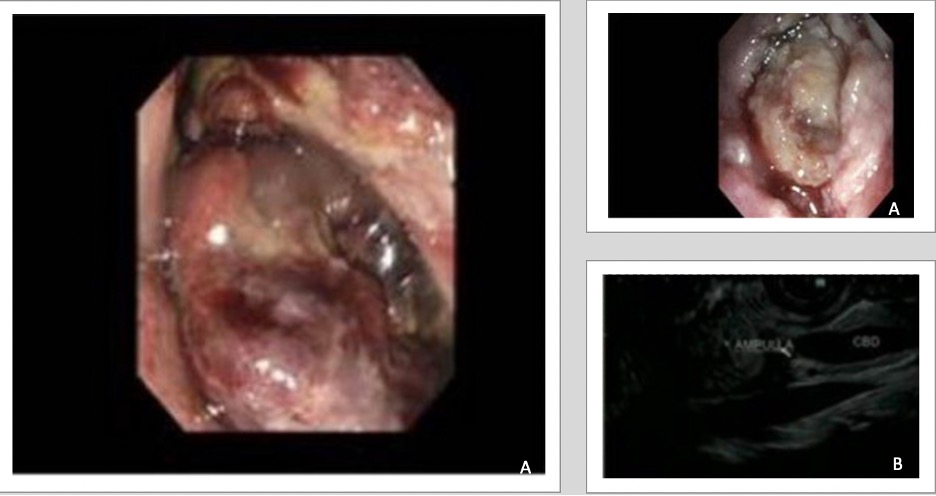Tuesday Poster Session
Category: Biliary/Pancreas
P3611 - The Importance of Sub-Typing: A Rare Case of Asymptomatic Intestinal Type Periampullary Carcinoma
Tuesday, October 29, 2024
10:30 AM - 4:00 PM ET
Location: Exhibit Hall E

Has Audio
- JJ
Jason John, DO
Jefferson Health
Pennsauken, NJ
Presenting Author(s)
Jason John, DO1, Brian Blair, DO2, Lucy Joo, DO2, Christopher Chhoun, DO2, C. Jonathan Foster, DO2, Neethi Dasu, DO3
1Jefferson Health, Pennsauken, NJ; 2Jefferson Health, Cherry Hill, NJ; 3Beth Israel Lahey Health, Burlington, MA
Introduction: Periampullary carcinoma is an extremely rare form of gastrointestinal malignancy that arises in the vicinity of the ampulla of Vater. The aggressive nature of these tumors stems from delayed diagnosis, as patients typically show no symptoms until the disease has reached an advanced stage. This malignancy typically presents with jaundice, abdominal pain, or unintentional weight loss. We present a case of an asymptomatic 71-year-old male who presented with minimally abnormal LFTs and was found to have periampullary carcinoma.
Case Description/Methods: A 71-year-old man presents with elevated liver function tests during routine outpatient lab work. His alkaline phosphatase was 137, ALT was 50, with an otherwise unremarkable hepatic function panel. Subsequent abdominal ultrasound revealed dilation of the intrahepatic and extrahepatic duct along with questionable pancreatic head fullness. Follow-up MRCP indicated a hypoenhancing lesion in the retroperitoneum, alongside persistent intrahepatic and extrahepatic biliary ductal dilation unrelated to the lesion. Given these findings, the patient underwent EUS/ERCP, which identified a 20mm x 14mm retroperitoneal lymph node, with intra-operative biopsy revealing lymphocytes and prominent ampullary soft tissue mass for which he underwent ampullectomy. FNA sampling was performed, which confirmed poorly differentiated carcinoma with focal expression of CDX2 and CK20. A Guardant360 liquid biopsy was performed, and it showed significant FGFR2 amplification as well as BRAF and EGFR without TP53 mutation. His case was discussed with the GI tumor board, and given his lack of surgical candidacy, was recommended to start 5-FU-based chemotherapy.
Discussion: Ampullary cancer is a rare disease entity that accounts for malignancy less than approximately 0.2% of all gastrointestinal tumors and often presents with distinctive symptoms such as abdominal pain and jaundice. These symptoms usually manifest earlier than other malignancies of the hepatobiliary system. There are two subtypes of ampullary cancer, which include the pancreaticobiliary and intestinal subtypes, the former being more common. Though there are notable improvements in differentiating between the subtypes of ampullary cancer, this distinction is only made in a minority of patients. Further research and awareness is necessary to highlight the different types of ampullary cancer given the significant clinical implications.

Disclosures:
Jason John, DO1, Brian Blair, DO2, Lucy Joo, DO2, Christopher Chhoun, DO2, C. Jonathan Foster, DO2, Neethi Dasu, DO3. P3611 - The Importance of Sub-Typing: A Rare Case of Asymptomatic Intestinal Type Periampullary Carcinoma, ACG 2024 Annual Scientific Meeting Abstracts. Philadelphia, PA: American College of Gastroenterology.
1Jefferson Health, Pennsauken, NJ; 2Jefferson Health, Cherry Hill, NJ; 3Beth Israel Lahey Health, Burlington, MA
Introduction: Periampullary carcinoma is an extremely rare form of gastrointestinal malignancy that arises in the vicinity of the ampulla of Vater. The aggressive nature of these tumors stems from delayed diagnosis, as patients typically show no symptoms until the disease has reached an advanced stage. This malignancy typically presents with jaundice, abdominal pain, or unintentional weight loss. We present a case of an asymptomatic 71-year-old male who presented with minimally abnormal LFTs and was found to have periampullary carcinoma.
Case Description/Methods: A 71-year-old man presents with elevated liver function tests during routine outpatient lab work. His alkaline phosphatase was 137, ALT was 50, with an otherwise unremarkable hepatic function panel. Subsequent abdominal ultrasound revealed dilation of the intrahepatic and extrahepatic duct along with questionable pancreatic head fullness. Follow-up MRCP indicated a hypoenhancing lesion in the retroperitoneum, alongside persistent intrahepatic and extrahepatic biliary ductal dilation unrelated to the lesion. Given these findings, the patient underwent EUS/ERCP, which identified a 20mm x 14mm retroperitoneal lymph node, with intra-operative biopsy revealing lymphocytes and prominent ampullary soft tissue mass for which he underwent ampullectomy. FNA sampling was performed, which confirmed poorly differentiated carcinoma with focal expression of CDX2 and CK20. A Guardant360 liquid biopsy was performed, and it showed significant FGFR2 amplification as well as BRAF and EGFR without TP53 mutation. His case was discussed with the GI tumor board, and given his lack of surgical candidacy, was recommended to start 5-FU-based chemotherapy.
Discussion: Ampullary cancer is a rare disease entity that accounts for malignancy less than approximately 0.2% of all gastrointestinal tumors and often presents with distinctive symptoms such as abdominal pain and jaundice. These symptoms usually manifest earlier than other malignancies of the hepatobiliary system. There are two subtypes of ampullary cancer, which include the pancreaticobiliary and intestinal subtypes, the former being more common. Though there are notable improvements in differentiating between the subtypes of ampullary cancer, this distinction is only made in a minority of patients. Further research and awareness is necessary to highlight the different types of ampullary cancer given the significant clinical implications.

Figure: Image 1: (A) Endoscopic imaging of ampullary mass (B) EUS depicting ampullary mass
Disclosures:
Jason John indicated no relevant financial relationships.
Brian Blair indicated no relevant financial relationships.
Lucy Joo indicated no relevant financial relationships.
Christopher Chhoun indicated no relevant financial relationships.
C. Jonathan Foster: Conmed – Consultant. Steris – Consultant.
Neethi Dasu indicated no relevant financial relationships.
Jason John, DO1, Brian Blair, DO2, Lucy Joo, DO2, Christopher Chhoun, DO2, C. Jonathan Foster, DO2, Neethi Dasu, DO3. P3611 - The Importance of Sub-Typing: A Rare Case of Asymptomatic Intestinal Type Periampullary Carcinoma, ACG 2024 Annual Scientific Meeting Abstracts. Philadelphia, PA: American College of Gastroenterology.
